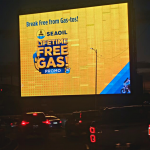Interview with Remi Roques, GM Broadsign APAC.
The introduction of digital screens transforms out-of-home advertising, but already, more change is on the horizon in the form of programmatic advertising. We sat down with Remi Roques, General Manager of Broadsign Asia Pacific, to talk about the next big thing in OOH – programmatic DOOH.
In recent years programmatic has been introduced to digital out-of-home around the globe. What benefits does it add to the already strong advertising medium for advertisers?
The OOH industry has been on a global growth streak for the last decade or so, largely thanks to the digitalisation of the inventory. DOOH has enabled publishers to run their inventory more effectively and increase the assets’ yield while reaching audiences with innovative messaging that is easily changed out in real-time. Programmatic DOOH automates all that, plus extra layers of data, targeting, and flexibility.
Would you say programmatic DOOH is the same as online programmatic?
While programmatic DOOH and online programmatic platforms have many common features, there are some important differences. Online display advertising appears on personal devices – the audience is receiving and interacting with the messaging in a very specific way. OOH advertising exists in the physical world and has its own unique role to play within the media mix. These differences need to be taken into account when planning and executing a campaign, especially when buying programmatically.
Some people think that programmatic DOOH will drive the prices down and existing OOH locations will be discounted during the buying process. Is this true?
Not at all. Brands pick DOOH sites based on the audience they need to reach. It’s the job of the supply side to find that audience. By bringing on more buyers to the demand side, programmatic actually increases the demand for DOOH inventory, which creates a premium and increases yield for publishers. The supply side also has full control over inventory availability and price – meaning it’s completely up to them which sites they sell and under what conditions.
There is a perception in the market that programmatic is designed to sell remnant inventory to brands. Is that true?
This is probably the most common myth about pDOOH. Publishers actually find that programmatic is an effective tool for generating a premium across their inventory. Brands determine what types of impressions are valuable to them, and publishers set a premium to access those impressions. In the world of pDOOH, there’s no such thing as “remnant inventory” – only impressions that haven’t been sold to the right buyer yet.
Does programmatic replace the media owner’s sales team?
Absolutely not. Programmatic is just another sales offering and is complementary to direct selling. Publishers who take advantage of the programmatic opportunity often bring in people with existing knowledge, experience and relationships into their business, or sometimes find value in creating an entirely separate sales team devoted to programmatic. There is no end to the potential revenue stream from pDOOH, as long as you have the right salespeople.
Is programmatic DOOH the ultimate way to sell OOH inventory?
Programmatic DOOH is an exciting space to be seeing as it is on a huge growth trajectory, but it’s not the “be all” and “end all”. The main challenge right now is deciding on methods of audience standardisation and improving on the reliability of measurement. As an industry, we need to work together and agree to adopt better processes. Once we get this right, with the growing demand and constant advancements in technology, pDOOH will only become stronger year after year.
MARKETING Magazine is not responsible for the content of external sites.









